Table of Contents
Understanding Discovery Platform Usage Survey, 2021
The Understanding Discovery Platform Usage survey provides insight into the discovery platforms used by potential and existing VuFind® users. The aim of the survey was to understand the platforms being used by these cohorts, including the features users liked, disliked, and wish they had in their existing discovery platforms. The survey results will be used to inform potential directions for future feature development of the VuFind® platform and inform future discussions with potential funders.
The survey instrument was sent to specific discovery communities (VuFind® and Blacklight) as well as the general library open source community (via Code4lib and other mailing lists) and survey responses were collected from November through December, 2021. A total of 49 usable responses were received.
Survey results
Over half of survey participants (59%) indicated that they used VuFind® and one-third indicated they used EBSCO Discovery Service. Just over one-quarter of participants (27%) indicated that they used multiple discovery platforms, with VuFind® and EBSCO Discovery Service being the most commonly cited combination of platforms used. Sixteen percent of participants indicated using other platforms not listed in the list of answer options. Other platforms used included Aspen Discovery, Enterprise (SirsiDynix), SAGE (a locally developed alternative to Blacklight), and Encore. One user indicated that their organization did not use a discovery platform because it was deemed to be too expensive to do so.
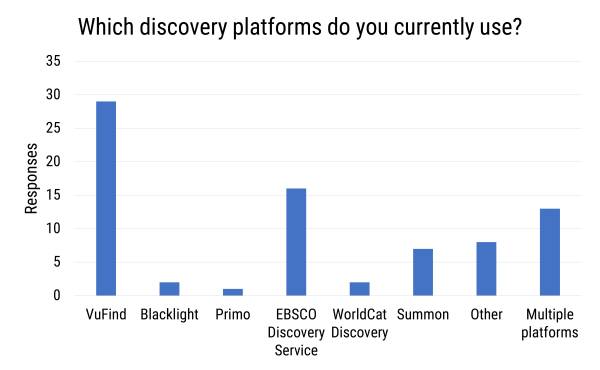
When asked about the approximate size of discovery platforms currently in use, 37% of participants indicated using platforms with 500,000 to 2 million records, and 27% of participants indicated using platforms that contained more than 50 million records. The majority of participants (71%) indicated using platforms of 500,000 records or more, and 29% of participants indicated using platforms containing fewer than 500,000 records.
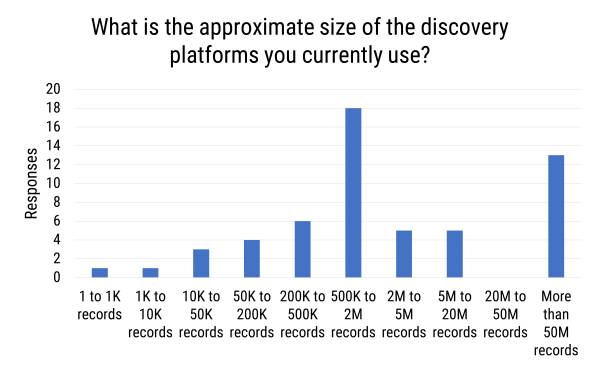
Survey participants searched primarily for online and downloadable documents and for printed / physical materials that could be loaned (92% and 86% of participants, respectively). In addition, 71% of participants indicated that they searched for bibliographic information on the discovery platforms they used, and 65% of participants noted that they searched for audiovisual materials. Only 12% of participants indicated searching for maps or georeferenced data, and 14% specified other types of information they searched for including streaming services, course reserves, research subject guides, institutional repositories, unique local digital collections, and equipment (i.e., lab, multimedia, power/charging cables, computers, hotspots, etc.)
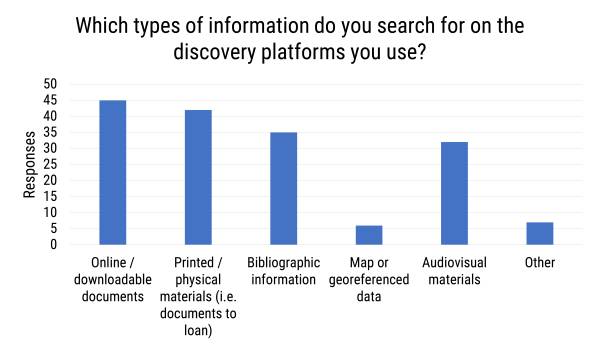
Over half of survey participants indicated that the discovery platforms they used were designed for either higher education users (i.e., faculty, staff, students) or for the general public (88% and 51% of survey participants respectively). Six percent of participants indicated that the discovery platforms they used were designed for either government staff, internal use by the hosting organization, or for other audiences such as domain specific experts, K-12 students, or musicologists and professional musicians.
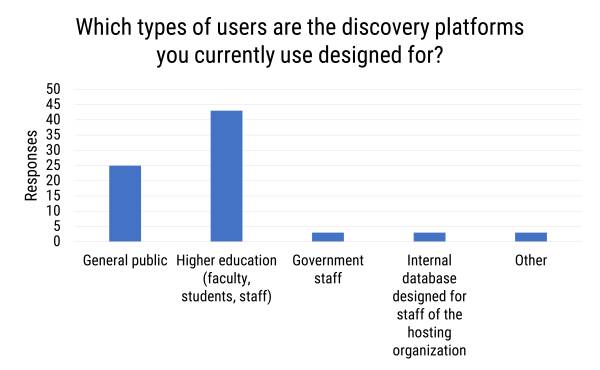
The top discovery platform features liked by survey participants included faceted navigation, real-time integration with an ILS, the ability to define and customize search types and fields, support for integration with third-party search APIs, standards-based export support (e.g. OAI-PMH, Z39.50, etc.), and internationalization. Features liked by less than one-third of survey participants included alphabetical heading browsing, bento box searching across multiple sources, authority record integration, social features such as tags, favorites, etc., and notification functionality (SDI). Other features liked by participants included wide coverage of browsing, multi-back end drivers, ability to adjust search rankings, usability and design of the platform, an interface for managing holdings, and a very supportive and dedicated international VuFind® team.
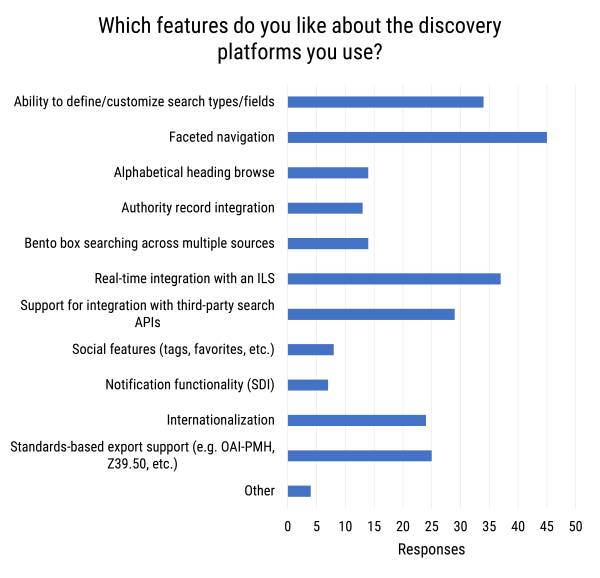
The top discovery platform features survey participants wish they had included authority record integration (41% of participants), the ability to define and customize search types and fields (29% of participants), and notification functionality (SDI) (27% of participants). Less than one-quarter of participants indicated that they wished they had support for integration with third-party search APIs, standards-based export support (e.g. OAI-PMH, Z39.50, etc.), real-time integration with an ILS, bento box searching across multiple sources, faceted navigation, alphabetical heading browse, internationalization, and social features such as tags and favorites. Other features participants mentioned that they wished they had included statistic usage of the platform, the ability to add/update existing records, tag editing and statistics (add a tag, edit tag metadata, etc.), FRBRized organization of resources, effective de-duplication of records, easier customization of the platform, automated uploading of OPAC using SAML, and LRM compliant presentation of information.
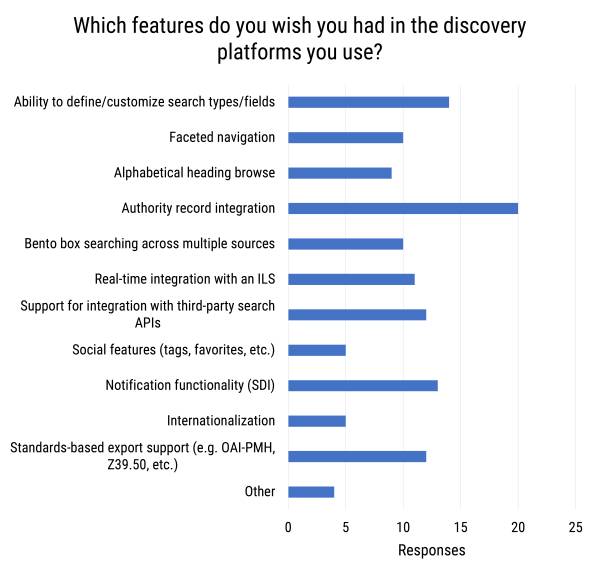
The top discovery platform features not important to or not used by survey participants were social features, notification functionality, bento box searching across multiple sources, and alphabetical heading browse functionality (39%, 24%, 20% and 20% of survey participants respectively). Sixteen percent of participants indicated that the internationalization features of the discovery platforms were not used or not important.
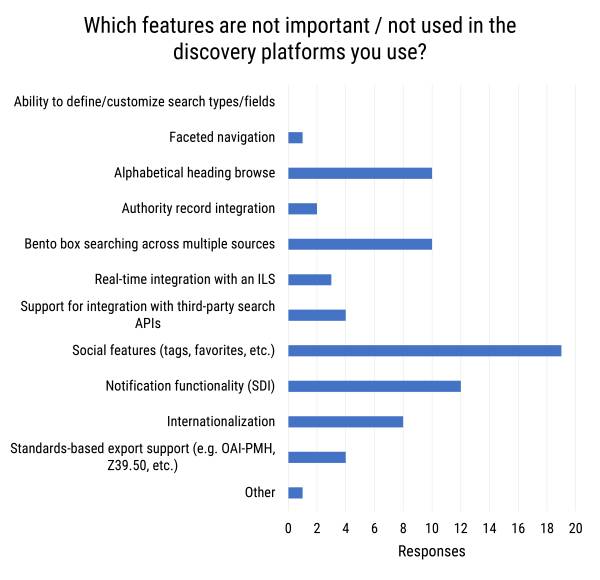
About the survey participants
Survey participants were primarily from academic libraries (n=39), with some users from public libraries (n=3), special libraries (n=1), research institutes (n=1), and other institutions (n=5) such as library consortia comprised of either only academic libraries, only intergovermental agencies, or a mix of academic, public, K-12, and special libraries.
Most survey participants were employed as library staff (n=25) or in other occupations such as IT specialists (n=12), software developers (n=8), educators (n=2), or researchers (n=2).
Survey participants resided in the following countries:
| Country | Number of participants |
| Argentina | 1 |
| Canada | 1 |
| Czech Republic | 1 |
| France | 1 |
| Germany | 9 |
| India | 3 |
| Ireland | 1 |
| Italy | 1 |
| Malaysia | 2 |
| New Zealand | 1 |
| Saudi Arabia | 1 |
| Spain | 1 |
| Sri Lanka | 1 |
| Sweden | 1 |
| Switzerland | 1 |
| Turkey | 1 |
| United States | 20 |

